Inhabiting freshwater wetlands in both coastal and inland areas, the White-faced Ibis has the distinctively-shaped bill of its relatives the White and Glossy Ibises. Many White-faced Ibis populations are migratory, but in addition to migratory movements they are prone to nomadic wanderings after the nesting season.
While White-faced Ibis do at times return to breeding areas in subsequent years, they are also subject to changing habitat conditions such as water levels from year to year, and will move some distance as needed to find suitable nesting conditions. They have been known to live over 14 years in the wild.
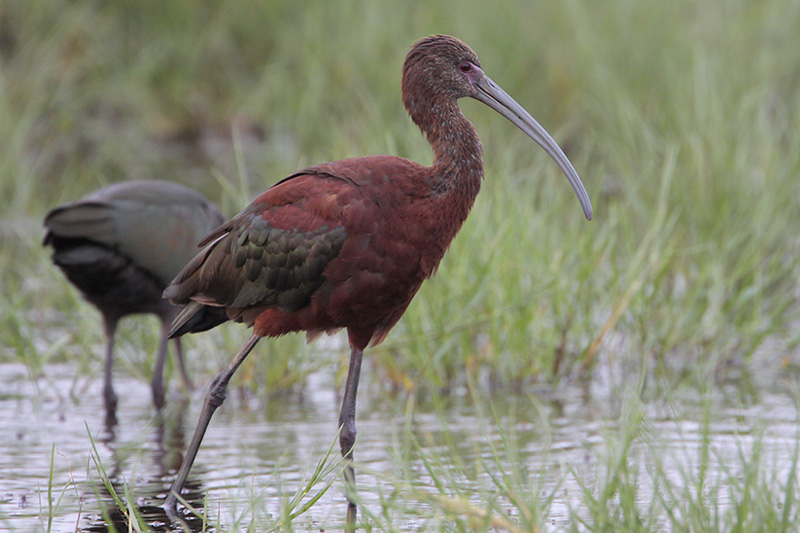
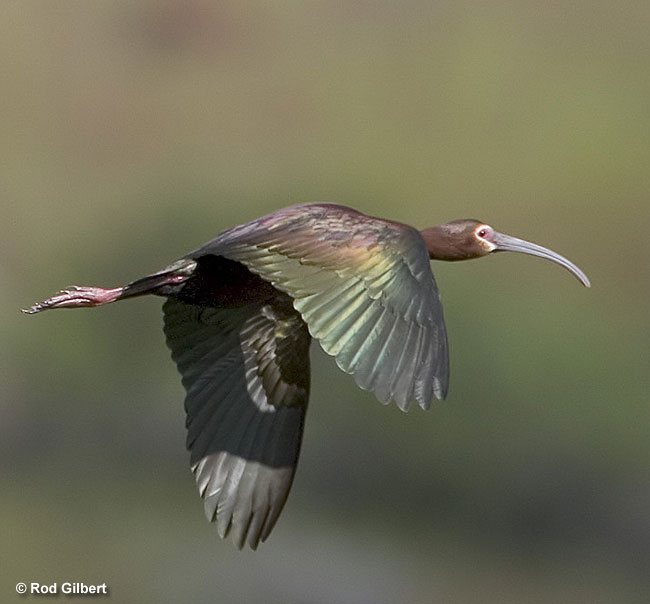
On this page
Description of the White-faced Ibis
BREEDING MALE
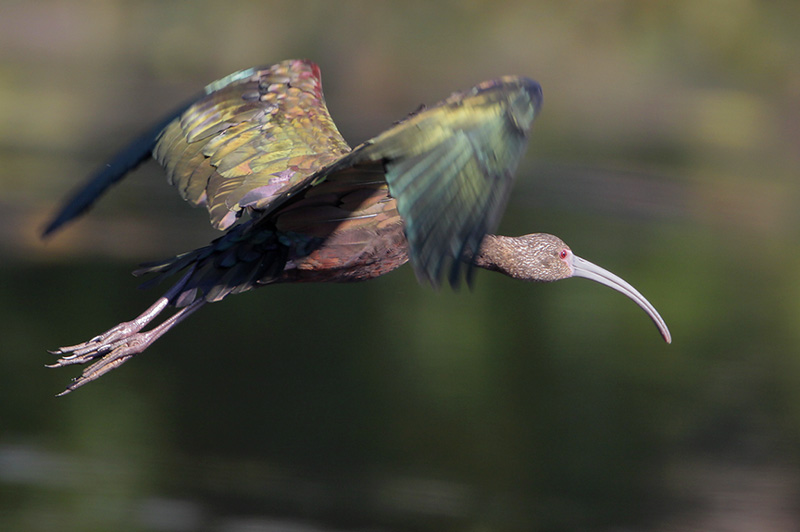
The White-faced Ibis has dark, glossy greenish wings and reddish neck and belly regions, with long, reddish legs and a long, decurved bill. Its eyes are reddish. White line around reddish facial skin meets behind the eye.
Female
Sexes similar.
Seasonal change in appearance
Plumage becomes browner and white facial line less distinct in winter.
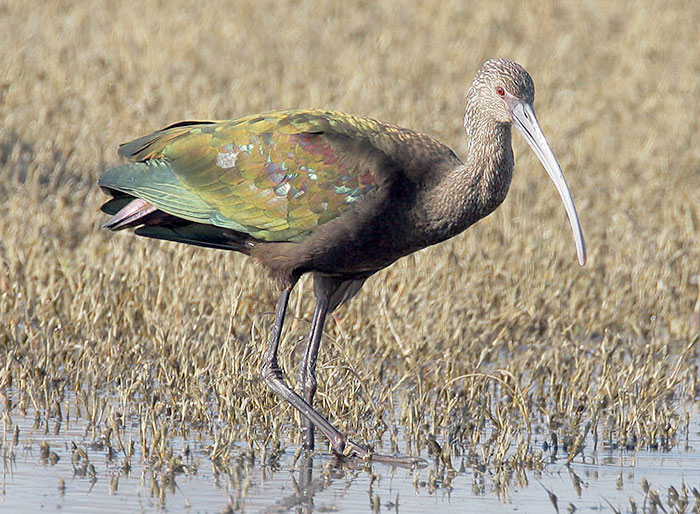
Juvenile
Juveniles resemble winter adults.
Habitat
Marshes and flooded fields.
Diet
Insects and crustaceans.
Behavior
Forages by walking and wading.
Range
Breeds locally across portions of the western U.S. and is resident in parts of California and the Gulf Coast. Also occurs in Mexico and Central America.
Fun Facts
White-faced Ibis tend to be less territorial than herons and egrets when breeding.
Incubation begins soon after the first egg is laid, so the young of a clutch will vary in size.
Vocalizations
Soft grunting or babbling sounds are made on the nesting grounds.
Similar Species
Glossy Ibis
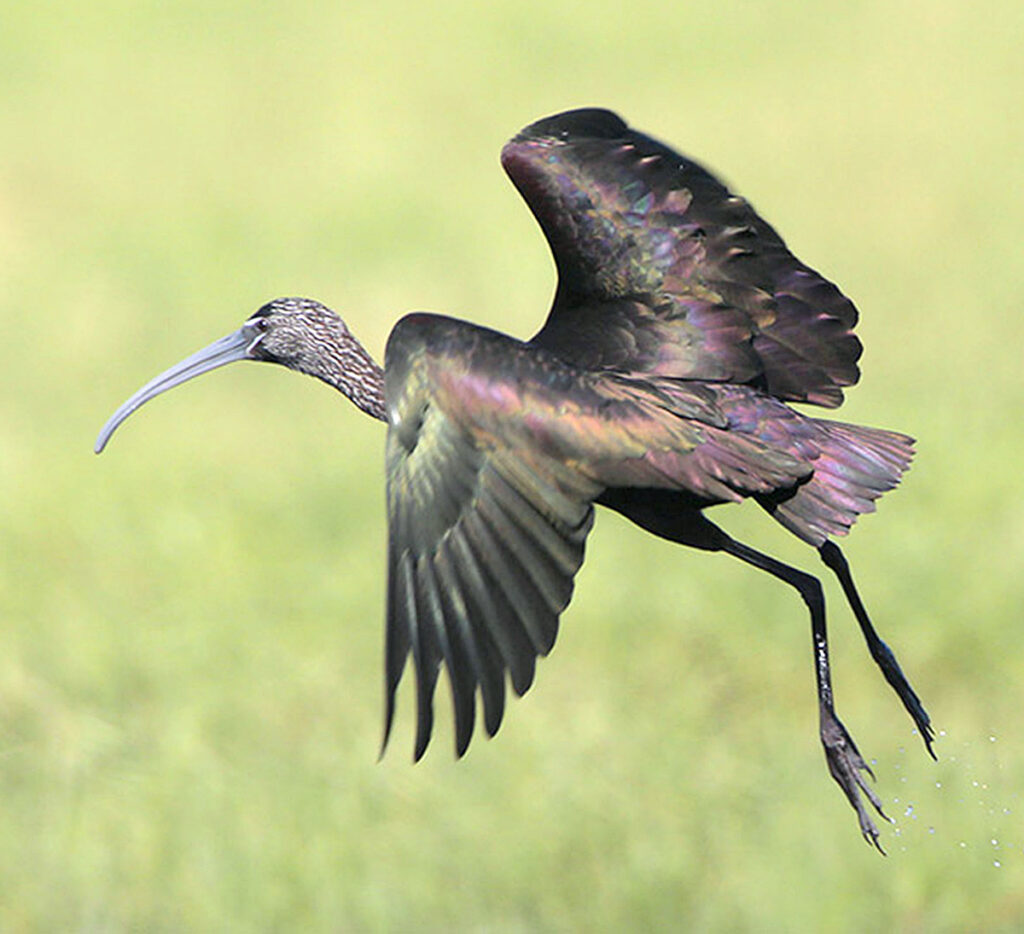
Photograph © Greg Lavaty.
Glossy Ibis have dark eyes, bluish facial skin, greenish legs with reddish joints, and a white line around the facial skin that does not meet behind the eye.
Nesting
The nest is a platform of plant material placed in a tree or in marsh vegetation.
Eggs: 3 to 4
Color: Pale bluish-green.
Incubation and fledging:
– Young hatch at 17-26 days.
– Young fledge (leave the nest) in 21-28 days after hatching but remain with the adults for some time.
Bent Life History of the White-faced Ibis
Published by the Smithsonian Institution between the 1920s and the 1950s, the Bent life history series of monographs provide an often colorful description of the birds of North America. Arthur Cleveland Bent was the lead author for the series. The Bent series is a great resource and often includes quotes from early American Ornithologists, including Audubon, Townsend, Wilson, Sutton and many others.
Bent Life History for the White-faced Ibis – the common name and sub-species reflect the nomenclature in use at the time the description was written.
PLEGADIS GUARAUNA (Linnaeus)
My first real aquaintance with this handsome bird was made in Texas in 1923, where we were told that there was a large breeding colony of “bronze ibises” to be found way off on the prairies of Ref ugio County. During a drive of some 70 miles over the rough muddy roads through the “hog-wallow prairies,” we had occasionally seen little bands of ibises feeding in wet places, or straggling flocks of them flying from the shores of ponds or banks of rivers, all heading in the same direction. They had been spread out over many miles of country to feed and were now returning to thtir rookery; the direction of their flight helped us to locate it. So we turned off the road and drove for some three miles across the prairie, picking our way through scattered clumps of mesquite and huisache, or dodging numerous prickly-pear cacti, until we came to the shore of a marshy lake. The shores of the lake were lined with tules and the center of it was one great tule swamp, separated from us by 50 yards of open water. Ibises were coming and going and over the tules a few of them were circling. But it was not until we had partially stripped and waded out to it, in water nearly up to our armpits, that we realized what a large colony we had found.
Nesting: Before we reached the tules the birds began to rise and soon there was a bewildering cloud of them circling overhead, uttering their peculiar cries of protest. And looking through the more open spaces we could see the large brown birds leaving their nests, flopping off over the water or scrambling through the thicker tules. Many of these were young birds, for at that date, May 19, most of the eggs had hatched and some of the young were able to fly. As soon as we entered the tules, which grew far above our heads, we began to find nests. Many of them were in the more open places where they could be plainly seen, but many more were in dense clumps of tules where it was difficult to penetrate. Progress was so slow and so difficult, in the deep water and dense tangles, that we did not attempt to explore the whole rookery; I could form no definite idea of its extent or how many birds it contained; but as far as we could see over the big expanse of marsh, birds were constantly arising and alighting; there must have been several thousands of them. The nests were built in more or less open clumps of tules and attached to them; some were partially floating shallow platforms barely above the water; others were well made and built up of 10 or 12 inches above the water. They were all made of coarse pieces of dead tules, the last year’s growth having been beaten down to form a foundation; they were often deeply cupped and were lined with finer pieces of tules and with grasses. Only a very few nests still held eggs, usually three.
The interesting colony, found near Brownsville, Texas, many years ago, described by George B. Sennett (1878) and Dr. J. C. Merrill (1879), had long since disappeared; the swamp has been drained and is now cultivated land. So far as I could learn there are now no ibises breeding in that section of Texas. Doctor Merrill’s (1879) account of it is as follows:
On the 16th of May, 1577, Mr. 0. B. Sennett and I visited a large patch of tule reeds growing in a shallow lagoon, about 10 miles from the fort, in which large numbers of this ibis and several kinds of herons were breeding. The reeds covered an area of perhaps 76 acres or less, growing in water 3 or 4 feet in depth Irregular channels of open water traversed the reeds here and there, but the bottom was comparatively firm, and there was little difficulty in wading in any direction. Besides the ibises, the great and little white egrets, Louisiana and night herons, and several other birds were breeding here. Often nests of all these species were placed within a few feet of each other, but there was a tendency toward the different kinds forming little nesting groups of 10 or 15 pairs. The reeds grew about 6 feet above the surface of the water, and were either beaten down to form a support for the nests, or dead and partly floating stalks of the previous years were used for that purpose. It was impossible to estimate the number of the ihises and different herons nesting here. On approaching the spot many would be seen about the edges of the lagoon or flying to or from more distant feeding grounds, but upon firing a gun a perfect mass of birds arose, with a noise like thunder, from the entire bed of reeds, soon to settle down again. Both nest and eggs of the ibises were quite unlike those of any of the herons, and could be distinguished at a glance. The nests were made of broken bits of dead tules, supported by and attached to broken and upright stalks of living ones. They were rather well and compactly built, and were usually well cupped, quite unlike the clumsy platforms of the herons. The eggs were nearly always three in number, and at this date were far advanced in incubation; many nests contained young of all sizes.
George Wilett and Antonin Jay (1911) visited a large breeding colony of white-faced glossy ibises in San Jacinto Lake, in Riverside County, California, on May 28, 1911, which they describe as follows:
In nearly every patch of tules was a nest or two of this species, and in the patch farthest west which coveted about a half acre, there must have been at least 200 nests. They were built on bent down tules, and were composed of tule stalks and lined with marsh grass. They were situated from 2 to 6 feet above the water, the average height being about 4 feet. About half the nests examined contained young and most of the others held badly incubated eggs. A very few fresh sets were found but the height of the nesting season was past. The sets almost invariably consisted of three or four eggs. In one or two instances sets of two incubated eggs were noted and three nests contained five eggs each, two nests six eggs each, and one nest had seven. It is probable that sets numbering more than five eggs were deposited by more than one bird. In fact they invariably showed two different types of eggs. The color of the eggs evidently fades with incubation, as the heavily incubated eggs are a much lighter blue than the freshly laid ones. This is probably the largest breeding colony of these birds in southern California west of the mountains.
A. 0. Treganza writes to me that this ibis is not an uncommon breeder in suitable localities in Utah. There is a colony of about 100 pairs on the black sloughs about 8 miles from Salt Lake City, a colony at the mouth of the Jordan River of about 100 pairs and he knows of four colonies, two of about 75 to 100 pairs and two of about 150 to 200 pairs at the mouth of Bear River. They breed in company with snowy egrets and black-crowned night herons and in three cases with Treganza herons, nesting in tules growing in water about waist deep. In some instances the nests are made on the dead tules of the year previous, which have been broken and matted down by the winter snows, while in other eases they consist of entirely new nests attached to and on the new growing tules and reeds.
Eggs: This ibis usually lays three or four eggs, but five, six or even seven have been found in a nest. They are ovate, elliptical vate or elong ate ovate in shape. The shell is smooth or very finely pitted, with little or no gloss. The color varies from “Niagara green” to “pale Nile blue.” The measurements of 46 eggs average 51.5 by 36 millimeters; the eggs showing the four extremes measure 66 by 37, 52 by 38, 46 by 35.5 and 50.5 by 33 millimeters.
Young: Incubation is said to last for 21 or 22 days and probably ï both sexes incubate, as is known to be the case with the glossy ibis. At the time we visited the rookery in Texas, referred to above, we found young of all ages from newly hatched to those which were able to fly. The youngest birds showed signs of fear, but remained in the nest or made only feeble attempts to leave it But the older birds, one-third grown or more, were very timid and very precocial; they left the nests as we approached and scrambled off through the tules with great agility and skill; the larger ones tried to fly and, if they fell into the water, they flopped over the surface or swam away.
Plumages: The downy young of the white-faced glossy ibis is not a beautiful creature. It is scantily covered with dull black down, through which the pin-feathers soon begin to show; there is a white patch on the back of the crown; the bill is pale flesh-color, black at the tip and at the base, with a black band in the middle. This parti-colored bill is also characteristic of the juvenal plumage and does not disappear until September. In the juvenal plumage the rich chestnut hues are wholly lacking; the head, neck, and under parts are dull grayish brown; but the plumage of the upper parts, back, wings, and tail, is a rich, glossy, metallic green. A partial molt in September produces a head and neck plumage much like that of the winter adult, streaked with brown and dull white. I have been unable to trace the first prenuptial molt in young birds, but presumably a partial molt produces a body plumage approaching that of the adult. At the first postnuptial molt, which is complete, the young bird assumes the adult winter plumage. Winter adults have the head and neck streaked with brown and dull white, as in the first winter; but the upper parts are glossed with purple, green, and bronze reflections, but little duller than in spring, and the under parts are rich chestnut brown. Adults apparently have a partial prenuptial molt in early spring, March, and a complete postnuptial molt in July and August.
Food: Like the white ibis, this species often makes long flights to its favorite feeding grounds, along the banks of rivers and on the shallow margins of muddy pools, ponds, and marshes. On the hog-wallow prairies” of the coastal plains of Texas are many such pools, where we often saw this species feeding, walking about gracefully and probing in the mud; the crops of birds we shot here were crammed full of ordinary earthworms. Its food also consists largely of crawfish, various small mollusks, insects and their larvae, small fish and frogs, newts, leeches, and various other forms of low animal life. Probably a certain amount of aquatic vegetation is also eaten.
Behavior: The name, “black curlew” has been well applied to this species, for at a distance in flight it certainly appears very dark colored; its long curved bill stretched out in front and its legs extended backward give it the shape of a curlew. It can be easily recognized at any distance. Its flight is strong, direct, swift and well sustained. ‘When traveling in flocks, it flies in long, diagonal lines, sometimes with the birds abreast, usually with steady, rapid wing strokes, but varied occasionally with short periods of scaling.
Dr. Frank M. Chapman (1908) was priviledged to see flocks of from 10 to 40 of these birds perform a surprising evolution; he writes:
In close formation, they soared skyward in a broad spiral, mounting higher and higher until, in this leisurely and graceful manner, they had reached an elevation of at least 500 feet. Then, without a moment’s pause and with thrilling speed, they dived earthward. Sometimes they went together as one bird, at others each bird steered its own course, when the air seemed full of plunging, darting, crazy ibises. When about 50 feet from the ground, their reckless dash was checked and, on bowed wings, they turned abruptly and shot upward. Shortly after, like a rush of a gust of wind, we heard the humming sound caused by the swift passage through the air of their stiffened pinions.
The same writer describes the note of this species as a “nasal echick-ook-iclc.” Dr. Joseph Grinnell (1918) records it as “a hoarse ka-onic, several times repeated.”
Game: Ibises can hardly be considered desirable game birds; yet, under the name of “brc7nze ibis” in Texas or “black curlew” in California, this species has been persistently hunted and sold in the market as game. Prior to 1915 there was an open season on it in California, with a bag limit of 20 birds, but, as many of the birds migrated out of the State during the open season, no great reduction in its numbers was made by gunners.
DISTRIBUTION
Breeding range: Western North America, including Mexico; South America, south of the Amazon Valley. Range discontinuous; prac~ tically unknown from Central America (south of Mexico) and northern South America. In North America, east to Louisiana (Lake Arthur); Florida (one record, at Lake Washington). South to Mexico (valley of Toluca, Mazatlan, and San Jose del Cabo). West to California (near Escondido, San Jacinto Lake, Los Banos, and Clear Lake). North to Oregon (Maiheur Lake), Nevada (Washoe Lake), Utah (Bear River marshes), and Minnesota (one record for Heron Lake). In South America, east to Brazil (Rio Grande do Sul), Argentina (Rozas, Cape San Antonio, and Estancia Sta. Elena). South to Argentina (Rio Negro). West to Chile (Santiago).
Winter range: II1 common with other members of this family, the white-faced glossy ibis is more or less resident in its breeding range. It does, however, regularly withdraw from the northern and southern extremes. In North America it winters north to California (San Diego and Los Banos), Arizona (casually at Tombstone); Texas (Corpus Christi and Brownsville), and Louisiana (Lake Prieu). The winter range in South America appears to be regularly south to Argentina (Cape San Antonio or Buenos Aires). In this portion of the range there is a distinct movement north in the latter part of September, indicating that the principal breeding areas may be located along the rivers and marshes of the interior.
Spring migration: Early dates of arrival are: California, San Francisco, March 28, and Fresno, April 20; Oregon, Malheur Lake, May 12; Arizona, Peck’s Lake, Verde Valley, April 12; Idaho, Rupert, May 19; Colorado, Durango, April 7, and Barr, April 4; Minnesota, Wilder, May 27.
Fall migration: Late dates of departure are: Oregon, Malheur Lake, October 4; California, Dunlap, September 8; Colorado, Barr, October 3, and Colorado Springs, October 10.
Casual records: Stragglers have been noted in North America from Washington (Clear Lake, about October 30, 1909); and British Columbia (Salt Spring Island in 1884, Sardis, fall of 1904, and also at the mouth of the Fraser River). It also has been recorded from the Straits of Magellan, Magallanes Territory, Chile, and from El Pozo, Diquis River, Costa Rica.
Egg dates: California: 92 records, May20 to July 15; 46 records, May 28 to July 5. Texas: 35 records, April 15 to June 6; 18 records, April 22 to May 19.


